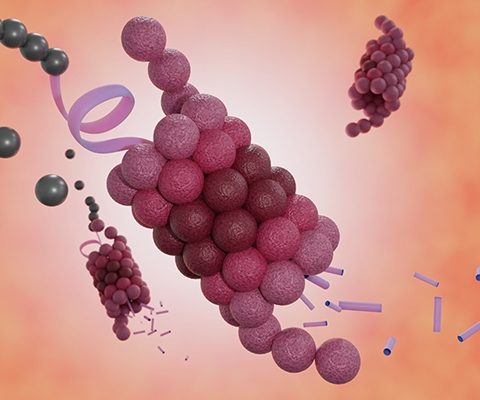From the journals: JBC
Creating the ideal PROTAC. A new player in mRNA polyadenylation. Improved inhibitors of human growth hormone signaling. Read about papers on these topics recently published in the Journal of Biological Chemistry.
Creating the ideal PROTAC

Proteolysis-targeting chimeras, or PROTACs, are drug molecules that consist of an E3 ubiquitin ligase-recruiting moiety and a target protein-binding moiety connected by a linker. These molecules work by binding a target protein and triggering ubiquitylation and subsequent degradation of that protein via the ubiquitin–proteasome system. Targeting molecules have been extensively developed, but the degradation moieties responsible for recruiting E3 ubiquitin ligases primarily target only two ligases, von Hippel-Lindau and cereblon, which limits the effectiveness of the PROTAC to specific cell and tissue types.
Jianchao Zhang, Caibing Ma and colleagues at the Southern University of Science and Technology and the Shenzhen Institute of Advanced Technology in China describe in a recent article in the Journal of Biological Chemistry a modified PROTAC that takes advantage of the N-end rule degradation pathway, which ties a protein’s stability to the identity of its N-terminal amino acid. They show that the addition of a single basic or hydrophobic amino acid attached via a linker to BCR-ABL ligand dasatinib was able to recruit E3 ubiquitin ligases of the UBR1 family. They also demonstrated the arginine–linker–dasatinib PROTAC had antitumor effects in a mouse that was surgically implanted with chronic myeloid leukemia cells.
These findings show that the addition of a single amino acid can effectively induce target protein degradation, which may improve drug efficiency and alleviate the development of drug resistance. They may also have implications for future PROTAC therapies that could even maintain protein concentrations within a given range by recruiting various tiers of E3 ubiquitin ligases.
A new player in mRNA polyadenylation
RNA-binding proteins directly bind to RNAs to regulate various biological processes, including RNA stability, localization and translation. One such protein, ZC3H11A, belongs to the transcription–export complex that binds capped, polyadenylated, and N6-methyladenosine–modified messenger RNA molecules and mediates their nuclear export. ZC3H11A is also vital for the replication of some viruses, such as adenoviruses, and can modulate inflammatory nuclear factor kappa light chain of activated B cells, or NF-κB, signaling in addition to its role in nuclear export. However, researchers have not yet detailed the biochemical features of ZC3H11A that mediate these functions.
In a recent paper in the Journal of Biological Chemistry, Katharina Kases, Erik Schubert and colleagues at Uppsala University in Sweden used mass spectrometry–based proteomics, co-immunoprecipitation and immunofluorescence to characterize the ZC3H11A interactome. They found that ZC3H11A binds to the nuclear poly-A binding protein PABPN1, mostly via its most N-terminal zinc finger motif, suggesting that ZC3H11A could play an additional role in mRNA 3’-end processing. Small interfering RNA inhibition of ZC3H11A revealed that this protein is recruited to PABPN1-bound mRNA species and functions at the polyadenylation step to fine-tune the length of the mRNA polyA tail. Finally, the authors showed that while multiple monopartite and bipartite nuclear localization sequences maintain ZC3H11A in the nucleus, PABPN1 interaction was necessary for its localization to nuclear speckles, which are thought to regulate gene expression and RNA processing.
Taken together, these findings identify ZC3H11A as a novel regulator of polyadenylation of nuclear mRNA, which enhances our understanding of gene expression in both animals and viruses.
Improved inhibitors of human growth hormone signaling
Human growth hormone, or hGH, is a secreted protein that regulates organ growth during development and is still expressed to a lesser degree through adulthood. Suppression of hGH binding to its receptor can protect against multiple diseases such as cancer and diabetes; however, the Food and Drug Administration has approved only one antagonist of the hGH receptor and no antagonists of hGH binding to the prolactin receptor, or PRLR, highlighting a need for additional therapeutic options.
A new generation of antagonists was designed recently to inhibit hGH binding to both the hGH receptor and PRLR. These antagonists, consisting of compounds G, G’, and D, are PEGylated, or bound to polyethylene glycol, to increase their half-life in the blood, but researchers have not yet characterized the location and size of the PEG conjugation which have variable effects on inhibitor efficacy.
In their new study published in the Journal of Biological Chemistry, Reetobrata Basu, Rich Brody, Uday Sandbhor and colleagues at the Edison Biotechnology Institute, Infinix Bio LLC and Ohio University describe the synthesis and purification of these compounds, as well as their affinities for disrupting both the hGH-to-receptor and hGH-to-PRLR interactions, using matrix-assisted laser desorption/ionization with time-of-flight mass spectrometry, size exclusion chromatography and thermostability assays. Furthermore, they show that treatment with compounds D and G improved the therapeutic efficacy of doxorubicin treatment in cancer cells, while compound G’ reduced levels of circulating insulin-like growth factor 1 in mice.
These dual antagonists of hGH signaling activity may have the potential for clinical applications after further development. They represent a promising strategy for treating growth hormone–associated pathologies.
Enjoy reading ASBMB Today?
Become a member to receive the print edition four times a year and the digital edition monthly.
Learn moreGet the latest from ASBMB Today
Enter your email address, and we’ll send you a weekly email with recent articles, interviews and more.
Latest in Science
Science highlights or most popular articles

Mining microbes for rare earth solutions
Joseph Cotruvo, Jr., will receive the ASBMB Mildred Cohn Young Investigator Award at the ASBMB Annual Meeting, March 7–10, just outside of Washington, D.C.

Fueling healthier aging, connecting metabolism stress and time
Biochemist Melanie McReynolds investigates how metabolism and stress shape the aging process. Her research on NAD+, a molecule central to cellular energy, reveals how maintaining its balance could promote healthier, longer lives.

Mapping proteins, one side chain at a time
Roland Dunbrack Jr. will receive the ASBMB DeLano Award for Computational Biosciences at the ASBMB Annual Meeting, March 7–10, just outside of Washington, D.C.

Exploring the link between lipids and longevity
Meng Wang will present her work on metabolism and aging at the ASBMB Annual Meeting, March 7-10, just outside of Washington, D.C.

Defining a ‘crucial gatekeeper’ of lipid metabolism
George Carman receives the Herbert Tabor Research Award at the ASBMB Annual Meeting, March 7–10, just outside of Washington, D.C.

The science of staying strong
Muscles power every movement, but they also tell the story of aging itself. Scientists are uncovering how strength fades, why some species resist it and what lifestyle and molecular clues could help preserve muscle health for life.

